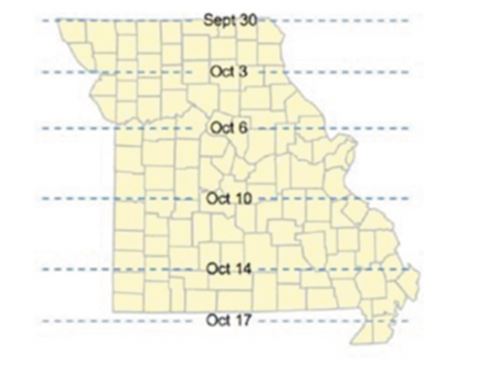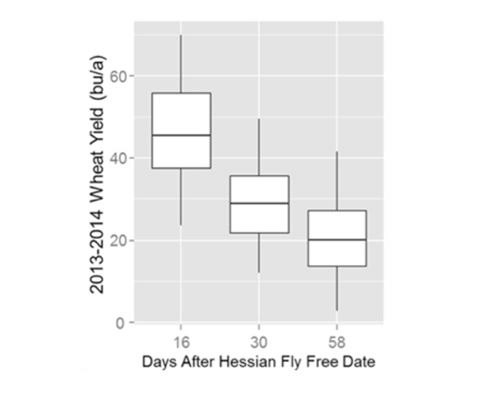|
Delayed Wheat Plantings May Effect Yields
DR. BRENT MYERS AND DR. WILLIAM WIEBOLD
COLUMBIA, MO.
With corn and soybean harvest slowed by uncooperative weather, wheat planting is also delayed. Missouri farmers will need to decide soon (if they have not already) whether or not to plant wheat this fall. An important piece of information needed to make that decision is the effect of planting date on wheat yield.
Predicting the response of wheat yield to planting date is complicated because seedling emergence and grain development occur in two different years separated by a winter dormant period. For corn and soybean, we can accurately predict that delayed planting will move grain filling of these two crops later into the season. Decreased sun energy and more adverse weather conditions during grain filling will often reduce corn and soybean yields. Delaying wheat planting may have little effect on the timing of grain fill. Instead, the effect of planting date on wheat yield is much less direct and highly dependent on weather conditions between planting and establishment of dormancy.
Wheat is a cool season grass with a minimum temperature for growth of 40°F or slightly cooler. But, wheat grows very slowly near this minimum temperature. To maximize yield, we depend on wheat plants to accomplish three things during the autumn growth period. First, it must develop a root system that will resist heaving. Heaving occurs when water freezes and thaws underneath the wheat crown. The expanding ice raises the plant upward and can completely jack the plant out of the soil. If this happens, the plants desiccate and die. Second, sugars are stored in the wheat crown. These sugars are needed to feed early growth in spring, but also help protect the growing point from freezing during the winter. With low concentrations of sugars and other solutes, wheat plants are vulnerable to winter kill. Third, wheat plants produce tillers (branches) in the fall. These tillers will produce grain heads the next spring. Wheat yield is severely decreased by inadequate tillering. Wheat plants can tiller in the spring, but it is unlikely that spring tillering can produce enough tillers to maintain yield potential.
These processes require active plant growth that is diminished if temperatures are too low or the time between emergence and dormancy is short. Since growth rate is so tightly linked to temperature, temperature after planting will greatly affect winter survival and the number of tillers. In turn, winter survival and the number of tillers will affect yield the next year.
The best place to begin a discussion on wheat planting date is with the fly free date. Figure 1 presents the fly free dates for Missouri. The female Hessian fly lays eggs on wheat seedlings. The maggots that hatch from those eggs feed by rasping leaf surfaces and drinking plant juices. The adult flies die in early fall. The timing of fly death is affected by cooling weather, thus, the fly free date in Missouri ranges from September 28 along the Iowa border to October 17 in the bootheel. Even if Hessian fly did not exist, the fly free date is recognized as the optimum date for planting wheat.

Figure 1. Hessian fly-free dates for Missouri.

Figure 2. 2013-2014 wheat yield loss due to delayed planting.
In the 2013 – 2014 winter wheat season we started an experiment on the effect planting date has on wheat yield at the Bradford Research and Education Center in Columbia, MO. Figure 2 presents the effect of planting date on wheat yield from the first year of this study. The x-axis is the number of days after the fly free date. While this is not enough data for us to develop recommendations, we will be collecting more over time. So far, these results are similar to data from adjacent states. As noted above, the fall weather after planting can have a large effect. Warmer than normal temperatures will allow additional growth and tillering, so the yield loss would be less. Cooler than normal temperatures will decrease growth and tillering, and yield loss could be greater than depicted in the graph. ∆
DR. BRENT MYERS: Assistant Professor, University of Missouri
DR. WILLIAM WIEBOLD: Professor, University of Missouri
|
|